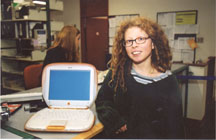
Above,
Susie Breier, Web Services Librarian, with the object of the pilot project.
Below, third-year Fine Arts student Stefano Strocelri uses an ibook
in the library.

|
by
David Weatherall
For students looking to add a little colour and a lot of mobility to their
next library experience, the Webster Library at the downtown campus is
now equipped to meet both of those demands. That’s because this fall
marked the beginning of the ibook pilot project by Instructional and Information
Technology Services (IITS) and the Library.
The project provides students with access to six Apple laptops (five blue
and one orange) and also provides the user with wireless Internet access
within a designated area on the library’s third floor.
“We had a strong desire to test the practicality of wireless technology
within the building,” said John Woodrow, Director of IITS. “As
it happened, the library was also looking to increase the access to their
resources. Out of these two needs came the ibook project.”
As an ever-increasing number of the library’s resources are becoming
electronic and available through the library’s Web site, making access
to that information simpler and more versatile is becoming an important
mandate.
“The tremendous problem with a wired network is that it is very cumbersome
to run wires and to maintain the network. There is also the fact that
with a wired CPU you are restricted in terms of your mobility,” Woodrow
said. “With wireless, there is the obvious plus of being mobile.”
The results of the project, at least thus far, have been very encouraging.
“All of the ibooks were out for the first day and they have been
taken out 1,132 times since then,” said Jean-Marc Edwards, Assistant
Director of Library Systems.
With this high-volume use, the question of security is a serious concern
in terms of the project’s success. Susie Breier, Web services librarian,
explained, “First, we have to make sure that the ibooks come back,
and we’ve taken measures to ensure that. We also have to preserve
the integrity of the university’s own network, so certain restrictions
have been built into the system.”
The project, now two months into its 10-month lifespan, is still experiencing
a few growing pains. The connection to the Internet depends entirely on
the ibook’s reception of the broadcast signal. According to Mike
Babin, assistant director at IITS, the signal is weaker when the ibook
is between the racks of books in the library.
People also present a bit of a interference problem, too. “The trouble
with working with this type of technology is that you cease to see people
as people,” Babin explained. “You have to start looking at them
as if they were six feet columns of water.”
Despite these mild glitches during the early stages, both parties involved
hold realistic high hopes for the goals of the endeavour. “The purpose
of the project is to see for ourselves how well the technology will work
in our buildings and to eventually determine what role wireless will take
in the library’s future,” Edwards said.
The process for borrowing one of the ibook’s is quite extensive,
as is to be expected when borrowing a $3,000 machine. Those wishing to
use the ibook services must first complete a registration form, which
allows them to take out the laptop for up to two hours. Upon return of
the ibook, users are encouraged to fill out a questionnaire that Breier
will use to measure the success of the project from the users’ perspective.
The ibook is open to all faculty, staff and students, and is offered on
a first-come, first-serve basis, so those wishing to use the services
should make haste to the periodicals desk. “I hear the orange one
is the most popular,” Babin added with a laugh, "so don’t
be disappointed if you end up with a blueberry one.
|
|
|



